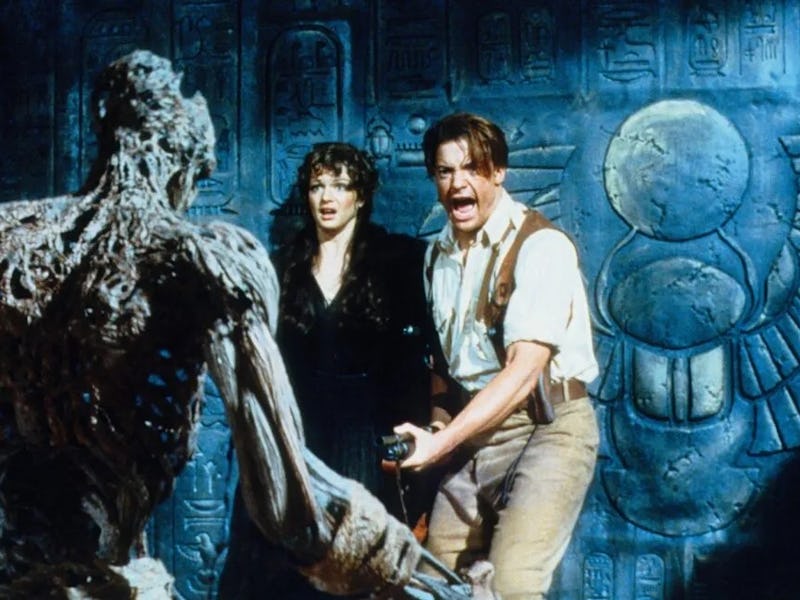1999’s The Mummy Remains the Platonic Ideal of the Remake
The secret to rebooting the Universal Monsters lies in the 1999 swashbuckler.

It’s been 25 years since Egyptologist Evelyn Carnahan (Rachel Weisz) read from The Book of The Dead and accidentally revived the mummified corpse of the cursed prieset Imhotep (Arnold Vosloo). But the swashbuckling adventure that followed, in which Evelyn, her brother Jonathan (John Hannah), adventurer Rick O’Connell (Brandon Fraser), and Medjai leader Ardeth Bay (Oded Fehr) must stop the quickly regenerating Imhotep from raising an army of the dead, has become the defining iteration of the story.
Today it’s hard to imagine the many possible versions of The Mummy that were conceived and abandoned prior to the Stephen Sommers’ film. Harder still is it to imagine an alternate universe where The Mummy film was scripted by George A. Romero or Clive Barker. Universal Pictures’ intention in resurrecting The Mummy was to create an updated version of the 1932 original. Given its whitewashed casting, and reduction of Egyptian culture, labeling The Mummy as a modern adaptation was as ambitious as the stunt-filled adventure film itself.
But while its intentions may have been ill-conceived, Stephen Sommers struck gold by tapping into the Tomb Raider craze of the time. Much like Indiana Jones and Lara Croft, Evelyn and her band of bumbling unintentional grave robbers have come to define an age of action movies where one character's fascination with history leads to unearthed treasures, undisturbed curses, and ancient myths coming to life.
A modern retelling wasn’t the only wish for Universal, and their goals went further than resuscitating The Mummy, with the hopes that the studio could also revisit its entire arsenal of Monsters. A successful run could enable them to return to other monsters such as Dracula, Frankenstein, or the Invisible Man. Audiences will never know what a Romero or Barker mummy film will look like, but Sommers’ action-filled adventure movie still has a touch of horror to it. Whether that be flesh-eating scarab beetles that burrow under the skin, or watching Imhotep sucks organs from his victims as early digital effects reanimate his flesh and fill into the rotting gaps of his face. These moments were chilling enough to remain fixed in our minds for decades to come, but by refraining from explicit gore, the film garnered a (relatively) safe PG-13 rating.
The Mummy’s balance of PG horrors and swashbuckling romance provided a crucial lesson in Hollywood remakes... that Universal has not really learned from.
In the last two decades, Universal have tried many times to reboot their Dark Universe. This has included returning to The Mummy once more with Tom Cruise as the lead, as well as the infamously terrible Morbius, and another recent flop, Renfield. With the notable exception of The Invisible Man, where Eliszabeth Moss is hunted by her possessive and undetectable husband, every other Universal Monsters project has tanked.
Universal's many attempts have since been unsuccessful due to their overcomplication of what — in their heyday — had never been complicated films. It seems that Universal keeps forgetting that simplicity is the key to these modernized monsters.
Before storming into Imhotep’s tomb for one last try at defeating the now fully revitalized mummy, Ardeth utters some rousing words to his fellow heroes: “Save the girl, kill the creature!” Much like the film itself, these are not complex instructions. If Universal insists on reviving the Monsters franchise, which there is a space for given the lack of horror films for younger audiences, it needs to look back on The Mummy to rediscover what worked. Maybe then it will stick: they don't need to reinvent the monster.